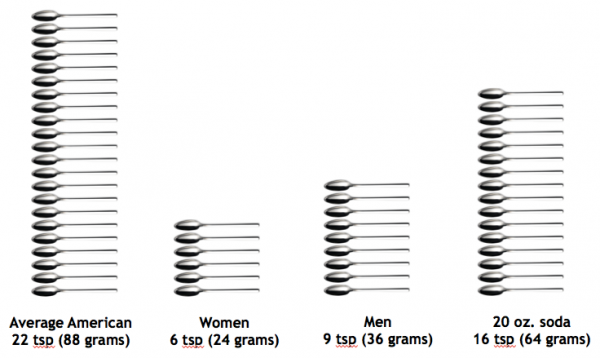Did you know the average American eats 22 teaspoons (~88 grams) of sugar per day??

The main sources of added sugar in the Typical American Diet are from sugar-sweetened beverages (soda, alcoholic drinks, sports drinks, fruit drinks), syrup, candies, cakes,… the usual culprits. It can also be found in some not so obvious sources as well, such as: sweetened yogurts, granola, sauces and syrups (spaghetti sauce, salad dressings, applesauce, teriyaki, cream sauces, etc.), condiments (BBQ, ketchup, hot sauce, chick-fil-a sauce), flavored oatmeal and cereal, breads, dried and canned fruit, baked beans, low-fat/non-fat products, frozen meals, some smoothies, protein powders.

How does sugar compare calorically to other sources?
1 gram of: sugar (considered a carbohydrate) = 4 calories; protein = 4 calories; fat = 9 calories; alcohol = 7 calories
Added sugars (those containing calories) may contribute a small about of calories but they, like alcohol, do not have the vitamins and minerals that other sources of calories offer. Sugars that are naturally occurring in fruit and unsweetened milk products are found in sources that have vitamins, minerals, fiber, and other nutritive sources that help to contribute to a balanced and healthful diet.
Sugar and Disease
Although correlation is not causation, high sugar intake has been correlated to increased risk of cardiovascular disease mortality, high blood pressure, and dental caries.2,3 It can contribute to the risk of developing diabetes and weight gain, there are tentative links between high sugar diets and some cancers.
Common Sources of Added Sugar
Honey, syrups (maple, malt, brown sugar, high-fructose corn syrup), sucrose (table sugar), corn sweetener, fruit-juice concentrates, nectars, raw sugars, fructose sweeteners, liquid fructose, anhydrous dextrose, molasses, or other words ending in “-ose,” (dextrose, maltose, etc.) the chemical suffix for sugar.4
What about non-nutritive sweeteners?
Non-nutritive sweeteners (NNS) are considered low-calorie, artificial or zero-calorie sweeteners that offer no nutritional benefits in the form of vitamins or minerals. The forms of NNS that are Generally Recognized As Safe (GRAS) by the Food and Drug Administration (FDA) are:
- Aspartame (NutraSweet® and Equal®)
- Acesulfame-K (Sweet One®)
- Neotame
- Saccharin (Sweet’N Low®)
- Sucralose (Splenda®)
*There is not sufficient evidence to about Stevia (Truvia® and PureVia®) for it to be considered GRAS. This does not mean the substance is harmful – there is simply not enough evidence for it to be deemed one or the other.4
What current research is saying:
- Caloric intake:
- Using non-nutritive sweeteners in either a calorie restricted or ad libitum diet will affect overall energy balance (lower calorie intake) only if the non-nutritive sweeteners are substituted for higher calorie food or beverages.5
- Appetite and food intake:
- Short term studies indicate that NNS do NOT affect appetite, nor does it increase food intake in adults.5
- Blood lipid and glycemic response:
- Limited research shows that NNS has no effect on the changes in blood lipid response and glycemic response for adults with diabetes.5
- Behavior, cognitive function, and mood:
- “Several studies report that in healthy adults and children, as well as those considered to have “sugar sensitivity” or behavioral disorders, intake levels of aspartame ranging from 10 – 60 mg/kg body weight (acceptable intake levels equal 50 mg/kg body weight) for time periods of 1 day to 12 weeks have not been shown to have any significant effect on behavior, cognitive function or mood. Further studies are needed using larger intakes of non-nutritive sweeteners over longer time periods.”5
What are the recommendations for added sugar intake?
The both the USDA Dietary Guidelines and World Health Association recommend consuming less than 10% of daily calories from added sugars for everyone.3,6 The American Heart Association Recommends limiting sugar intake to no more than 9 teaspoons (36 grams) per day for men and 6 teaspoons (25 grams) per day for women.7
How can you implement these recommendations in your diet?
- You should be aware of the added sugars in your diet and practice moderation. If you enjoy a teaspoon of honey in your morning coffee, that is perfectly fine!
- Focus on fueling your body with whole foods that have little to no added sugar in them. The closer to the source (produce, whole grains, unprocessed meats) the better! Treat non-nutritive sweeteners as you would nutritive sweeteners (added sugar) to ensure you maintain a balanced and healthful diet.
- Read the label, read the label, read the label! As you make your way through the grocery store, take a moment to double check the sugar content of the processed products you pick up, then select the best option with the least amount of sugar. You may be surprised where added sugars are sneaking into your diet!
Following these simple recommendations will have you on your way to a healthy and vibrant diet.
References:
1. Frequently asked questions about sugar. The American Heart Association. http://www.heart.org/HEARTORG/HealthyLiving/HealthyEating/HealthyDietGoals/Frequently-Asked-Questions-About-Sugar_UCM_306725_Article.jsp#.WKMQ4hIrKgA. Updated May 19, 2014. Accessed February 14, 2017.
2.Yang Q, Zhang Z, Gregg E, et al. Added Sugar Intake and Cardiovascular Disease Mortality Among US Adults. JAMA Internal Medicine. April 2014.
3. Guideline: Sugars intake for adults and children. Geneva: World Health Organization; 2015.
4.Stuff: How Sugars and Sweeteners Affect your Health. NIH News In Health. https://newsinhealth.nih.gov/issue/oct2014/feature1. Published October 2014. Accessed February 13th, 2017.
5. Nutritive and non-nutritive sweeteners. Academy of Nutrition and Dietetics: Evidence Analysis Library. Published 2006. Updated 2006. Accessed February 14, 2017.
6. USDA Dietary Guidelines 2015-2020. https://health.gov/dietaryguidelines/2015/guidelines/appendix-7/. Published May 2015. Accessed February 14, 2017.
7. Added Sugars. The American Heart Association. http://www.heart.org/HEARTORG/HealthyLiving/HealthyEating/Nutrition/Added-Sugars_UCM_305858_Article.jsp#.WKMadRIrKgA. Updated February 1, 2017. Accessed February 14, 2017.

